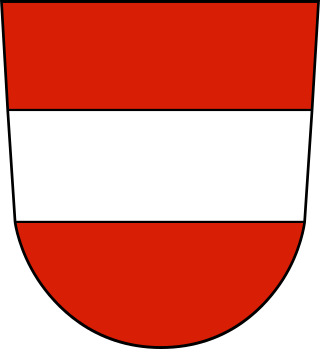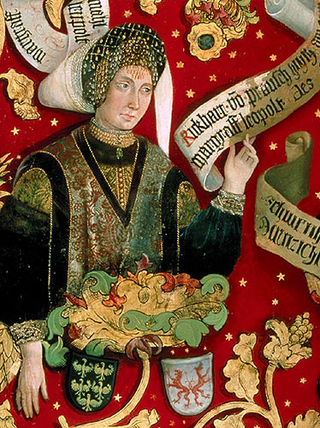See also
- Pidgey, the English name for Poppo in the Pokémon series
- All pages with titles containing Poppo
Poppo can mean:

The House of Babenberg was a noble dynasty of Austrian Dukes and Margraves. Originally from Bamberg in the Duchy of Franconia, the Babenbergs ruled the imperial Margraviate of Austria from its creation in 976 AD until its elevation to a duchy in 1156, and from then until the extinction of the line in 1246, whereafter they were succeeded by the House of Habsburg, to which they were related.
Pope Damasus II was the head of the Catholic Church and ruler of the Papal States from 17 July 1048 to his death on 9 August that same year. He was the second of the German pontiffs nominated by Emperor Henry III. A native of Bavaria, he was the third German to become pope and had one of the shortest papal reigns.
Adalbert is a German given name which means "noble bright" or "noble shining", derived from the words adal and berht. Alternative spellings include Adelbart, Adelbert and Adalberto. Derivative names include Albert and Elbert.

Leopold I, known as the Illustrious, a member of the House of Babenberg, was Margrave of Austria from 976 until his death. He was the first margrave of the Babenberg dynasty which ruled the March and Duchy of Austria until its extinction in 1246.
Adalbero or Adalberon is a masculine given name, a variant of Adalbert, derived from the Old High German words adal ("noble") and beraht ("bright") or bero ("bear"). It may refer to:

The Prince-Bishopric of Würzburg was an ecclesiastical principality of the Holy Roman Empire located in Lower Franconia, west of the Prince-Bishopric of Bamberg. Würzburg had been a diocese since 743. As established by the Concordat of 1448, bishops in Germany were chosen by the canons of the cathedral chapter and their election was later confirmed by the pope. Following a common practice in Germany, the prince-bishops of Würzburg were frequently elected to other ecclesiastical principalities as well. The last few prince-bishops resided at the Würzburg Residence, which is one of the grandest Baroque palaces in Europe.

Rudolf I was the Bishop of Würzburg from 892 until his death. He was the youngest son of Udo of Neustria.

The House of Henneberg was a medieval German comital family (Grafen) which from the 11th century onwards held large territories in the Duchy of Franconia. Their county was raised to a princely county in 1310.

The Prince-Bishopric of Bamberg was an ecclesiastical State of the Holy Roman Empire. It goes back to the Roman Catholic Diocese of Bamberg established at the 1007 synod in Frankfurt, at the behest of King Henry II to further expand the spread of Christianity in the Franconian lands. The bishops obtained the status of Imperial immediacy about 1245 and ruled their estates as Prince-bishops until they were subsumed to the Electorate of Bavaria in the course of the German Mediatisation in 1802.
Saint Arn or Arno von Endsee was the Bishop of Würzburg from 855 until his death. He was a pupil of Bishop Gozbald, who died on 20 September 855; Arn was elected bishop in his place. Arn was a warrior-prelate, recorded fighting against almost every external foe of the Germans at one point or another during his career.
The County of Regenstein was a mediaeval statelet of the Holy Roman Empire. It was ruled by the Saxon comital House of Regenstein, named after their residence at Regenstein Castle near Blankenburg north of the Harz mountain range.

The Diocese of Würzburg is a diocese of Catholic Church in Germany. The diocese is located in Lower Franconia, around the city of Würzburg, and the bishop is seated at Würzburg Cathedral. Founded in 741, the diocese lost all temporal power after the Napoleonic wars.

Regenstein, also Reinstein, was a Lower Saxon noble family, which was named after the eponymous Regenstein Castle near Blankenburg on the edge of the Harz Mountains of central Germany.
Poppo I may refer to:

Richardis of Sualafeldgau was Margravine of Austria from 976 until 994 as consort of the first Babenberg margrave Leopold I.
Rudolf I may refer to:
Several German nobleman were called Henry of Berg. They are divided into two families referring to different places named Berg. These are: